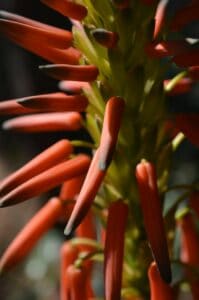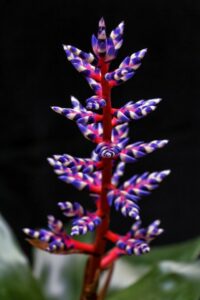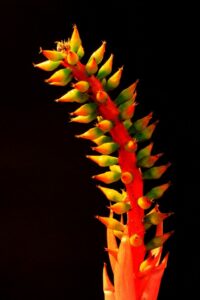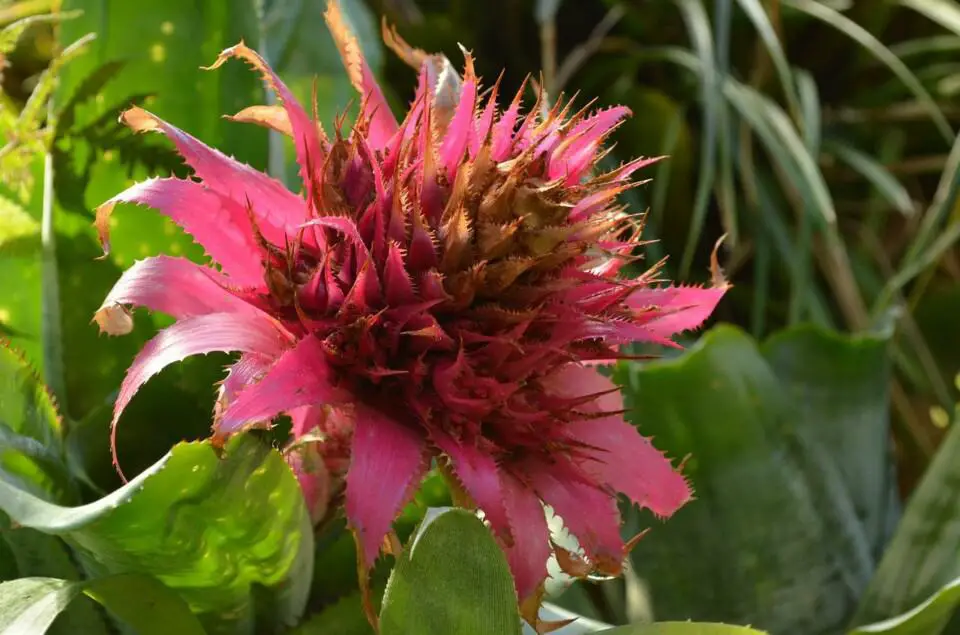Some links in the post are affiliate links and I get a commission from purchases made through some links found in the post.
Is your bromeliad turning brown? I will address this concern in two ways. The first relates to the flower, while the second covers the plant turning brown.
Your bromeliad flowers are sure to turn brown as this signifies that they have reached full bloom. These flowers, while long-lasting, eventually must bloom and die.
And since no flower can bloom forever, this is something we must accept about bromeliads. It’s a natural process. So, is there anything you can do about it?
You can hasten the process by cutting the flower off at its stem. After all, the flower will fall off eventually after it dies, and browning is just the start of the process.
If you would rather get rid of the eyesore, get a sharp sterilized knife, and cut off the flower. And that solves our first concern.
But what if the plant’s leaves have started browning? Cutting off the browning leaves is not ideal.
So, is there another way to deal with this change in hue? Yes! Browning signifies that the plant is not happy with its environment.
And this could owe to inadequate access to moisture (due to underwatering or low humidity levels) or too much exposure to light.
The reasons your bromeliad plant is turning brown is due to underwatering, overwatering, old age, a bad choice of potting mix, high temperatures, low humidity and too much light exposure.
The main reason being old age, the pups will usually start growing off the mother plant before the mother plant dies.
I break down how these factors affect your plant and how you can give it the optimal care it so deserves:
Why Is My Bromeliad Plant Turning Brown?
Generally, the bromeliad is one of the easiest plants to take care of – even beginners would attest to this.
However, even the lowest maintenance plants still need some TLC to thrive. And when you neglect them, they do not hold back on showing their displeasure. So, why could your bromeliad have had a change of heart (hue)?
1) Underwatering
 Have you ever come across a tropical plant that does not enjoy moist soil?
Have you ever come across a tropical plant that does not enjoy moist soil?
Most tropical plants have become accustomed to humid and moist environments and prefer to be in similar conditions. And the bromeliad is one such plant. When it goes without water for so long, you notice changes such as:
- Browning on its leaves, and
- Dryness in its leaves, which feel and look crispy to the touch.
Such changes are the plant’s cry for help. It desperately needs moisture to sustain its activities, including transpiration and evaporation.
Without water, it cannot make enough food for its growth, and if you leave it long enough in such conditions, it can wilt and die.
But what causes underwatering? Some of the causes will jump right at you, and some may not be so obvious:
Not Following a Regular Watering Schedule
The issue here could be that you go for long periods without feeding the plant with water. Maybe you go several weeks without giving the bromeliad a second thought.
Or you water it often but don’t give it enough water to soak through the potting mix. In these cases, the plant’s roots don’t have much to absorb, and the plant thus suffers.
Changing your watering schedule
If you have not been keen on watering the plant regularly, it’s time you considered it. The bromeliad needs water each time its top layer of soil feels dry to the touch.
When watering the plant, you should ensure you soak the potting mix such that you see the excess water coming out of the drainage holes at the bottom. That assures you that every inch of the soil has absorbed enough moisture.
Soaking the Bromeliad
If your plant appears browned and wilted, it’s always good to give it a thorough soak before amending its watering schedule. Here’s what you do:
- Fill a basin with about three inches of room temperature water,
- Place the bromeliad plant pot in the water such that its potting mix absorbs the water through the pot drainage holes,
- Leave the pot in the water for about half an hour,
- Dig into the top layer of soil and check if it feels moist. If it’s yet to feel moist, water the potting mix from the top,
- Drain the basin of water and allow the excess water to drain from the pot into the basin, and
- Move the pot back to a spot with adequate lighting and optimal temperature.
Often, people think of overwatering as a danger to bromeliads. And they are right to think so because these plants have a low tolerance to waterlogging.
But that does not make underwatering any less damaging to the plants. The best way to avoid these extremes is to stick to a regular watering schedule and invest in a moisture gauge.
You may also like: 6 great benefits of having a bromeliad in your home
2) A Highly Draining Potting Mix
While waterlogged soil is not good for the bromeliad, dry soil does not favor it. Such soil does not create the ideal conditions for the uptake of nutrients and should thus be avoided.
How to Fix a Bad Potting Mix
Your bromeliad needs to be moist rather than dry or wet soil. And the way to create this balance is to mix one part of sand with two parts of peat-based soil.
That allows enough water to drain without robbing the soil of moisture to sustain the plant’s activities.
3) High Temperatures

Do you change your watering schedule when the temperatures soar? It might be time you considered this. When summers come along, the temperatures tend to be unbearable, even for plants.
So, they lose a lot of water to the environment, as do their potting mixes. You need to up your watering regimen and give the plant more water in such circumstances.
Do any of these causes stand out to you?
Fixing High Temperatures
While you cannot stop summer from being hot, you can change how you protect your plant.
Move the plant to a cooler room, water it more often, and keep it away from heating vents and hot drafts. That will help the plant retain more of its moisture.
You may also like: Why are my bromeliad leaves turning yellow
4) Low Humidity
It’s always good to understand a plant’s native habitat because you can avoid placing it in unfavorable conditions.
Bromeliads are tropical plants that thrive in high humidity. When the levels become low, the plant dries out fast, and you notice changes such as:
- Browning of the leaves, and
- Drying of the potting mix.
Usually, the browning is minimal at the beginning. It only appears on the leaf edges and is barely noticeable. But when you ignore it, the hue change becomes more aggressive to the point that the leaves even start curling.
How Do You Fix Low Humidity?
Bromeliads prefer humidity that’s at least 60%. So, the first thing to do is assess your humidity levels using a hygrometer. If they are lower than 60%, this is what you can do to improve them:
- Install a humidifier in your home,
- Misting the bromeliad regularly (a few times a week should be enough),
- Leaving the kitchen and bathroom doors open,
- Boiling water on the stove more often,
- Placing a bowl of water near the plant, and
- Moving the bromeliad near other plants.
Please note that humidity levels change with the seasons. So, you will likely need to adjust them when winter and summer come along.
5) Too Much Light Exposure
Just how much light constitutes too much for the bromeliad? This question is challenging to answer as it depends on the type of species you have in your space.
But one thing is for sure – too much light can cause browning in your bromeliad. Below are the types of browning you may notice in your plant:
- Overall leaf browning: This change results from too much light or direct sun exposure. That’s right – even too much bright indirect light can harm your plant
- Browning on the leaf tips: While light is essential to the growth of the bromeliad, too much of it can damage the leaves. And this is what you see in the form of browning leaf tips.
- Brown spots: This issue arises from exposure to direct sunlight or too much light.
Direct sunlight burns the leaves of the bromeliad, resulting in leaf surface turning brown. Please read on for more on how you can deal with this issue before it kills your plant.
How to Deal with Lighting Issues
 Bromeliads are often sensitive to direct sun exposure. As such, leaving them outdoors is not ideal. Instead, you should position them in a spot with medium to bright indirect light.
Bromeliads are often sensitive to direct sun exposure. As such, leaving them outdoors is not ideal. Instead, you should position them in a spot with medium to bright indirect light.
If your bromeliad show signs of the leaves turning brown, move them towards less light. Please note that lighting needs differ by species, and it is always best to address your plant’s needs individually.
Be careful not to leave the plant in poor lighting as it is also just as bad as it deprives the plant of the ability to make food.
If you need more information on how to get the light correct for your bromeliad, we have an article on the bromeliad’s light requirements.
Final Thoughts
Browning, unlike yellowing, comes down to a few factors. So, it’s quite easy to figure out what’s ailing your plant and tackle the issue before it gets worse.
As you do so, remember to offer your plant the care it needs so you can avoid other problems.
Happy Gardening!
Before you go, here are some more related articles I encourage you to read below to help solve more of your gardening issues:

